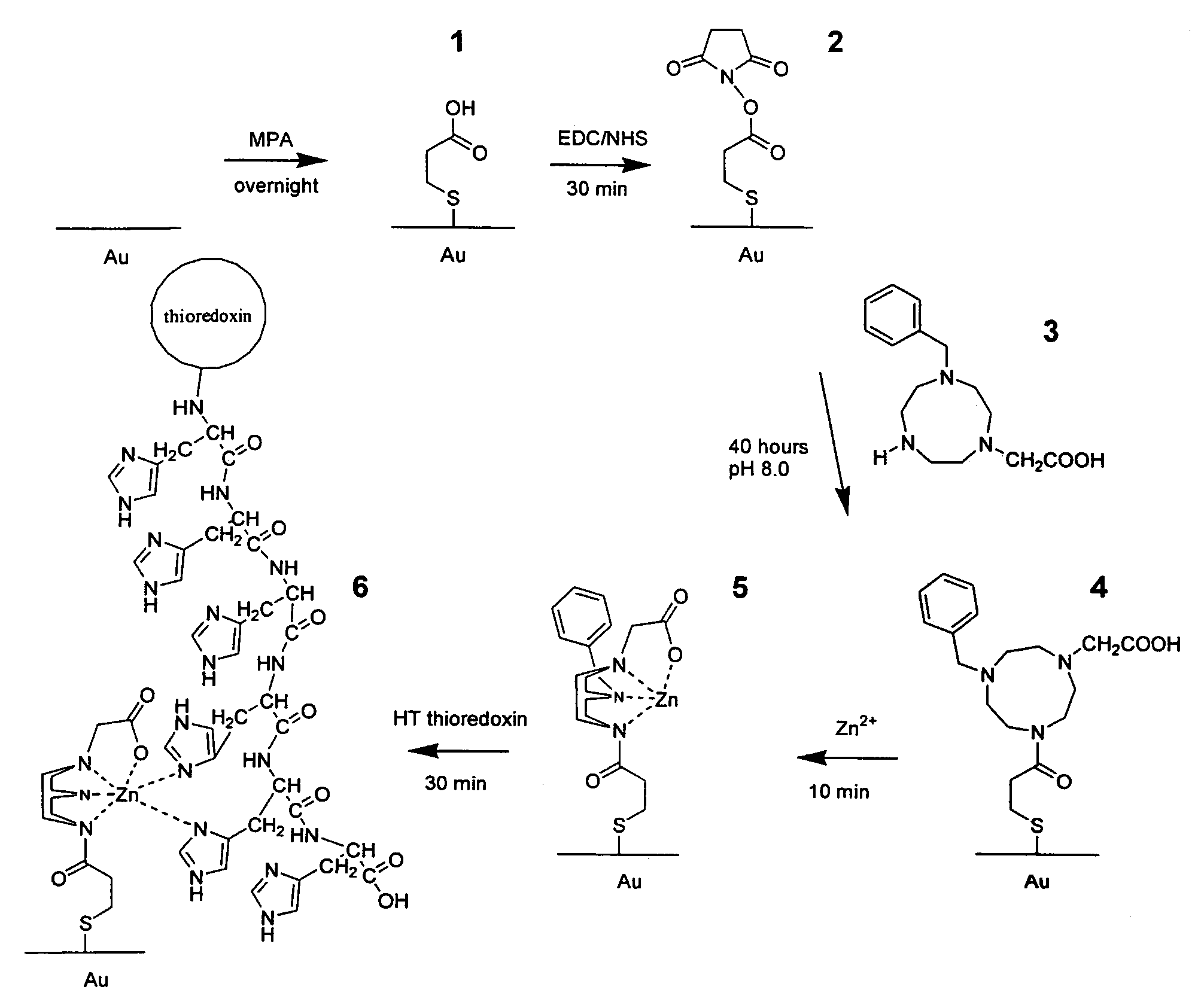Sensor chips
a technology of sensor chips and sensors, applied in the field of sensor chips, can solve the problems of limiting the required sample volume, many available sensor chips have some limitations in the range of detection, test sample volume, reproducibility, etc., and achieve the effects of increasing the efficiency of any interaction, increasing sensitivity and reliability, and enhancing the range of suitable applications
- Summary
- Abstract
- Description
- Claims
- Application Information
AI Technical Summary
Benefits of technology
Problems solved by technology
Method used
Image
Examples
example 1
Preparation of Self Assembled Monolayers (SAMs)
[0083]Self assembled monolayers of molecules of interest were formed on a gold surface. The immobilization protocol is outlined in FIG. 1.
[0084]A clean gold surface was modified with a mercaptopropionic acid (MPA) SAM, designated 1 and the monolayer was subsequently modified with EDC / NHS to create the NHS intermediate 2. Specifically, a gold sheet was placed in a 5 mM solution of MPA (75:25 w / w Ethanol:H2O) overnight. The surface was then washed with ethanol to remove unbound MPA, and dried under a stream of N2. The dried gold sheet was placed into an aqueous solution containing 75 mM EDC and 25 mM NHS for 30 minutes, washed with water and used immediately.
[0085]The modified macrocyclic amine, 1-acetato-4 benzyl-1,4,7 triazacyclononane 3, was synthesized according to the method described in Warden et al. (Org. Lett. (2001) 3(18) 2855-2858) incorporated herein by reference. The gold sheet that had been modified to 2 was then placed into ...
example 2
Analysis of SAMs
[0087]The SAMs prepared according to Example 1 were examined using electrochemical cell and surface characterization techniques that are described in the literature (see, e.g., D. L. Johnson, J. Thompson, S. M. Brinkmann, K. L. Schuller & L. L. Martin, “Electrochemical Characterisation of purified Rhus vernicifera laccase—voltametric evidence for a sequential 4-electron transfer,”Biochemistry (2003), 42:10229-10237 and references therein).
[0088]DRIFT (FIG. 2) and XPS experiments (not shown) were consistent with the proposed surface chemistry. DRIFT analysis was performed on fine silver powder modified according to FIG. 1. DRIFT analysis of the preparatory stages 1, 2, and 4 are shown in FIG. 2. Successful surface modification can be clearly seen in the C—H and C═O stretching regions. Structure 1 displays one C═O stretching vibration resulting from the COOH functionality, Structure 2 displays two distinct C═O stretching vibrations resulting from the —COON— moiety and ...
example 3
Electrochemical Behaviour of Immobilised Thioredoxin: Comparison of Oriented and Non-Oriented Monolayers
[0089]The self assembled monolayer was studied using direct electrochemistry on histidine-tagged E. coli thioredoxin. Thioredoxin is the simplest member of a growing superfamily which regulate redox operation through a disulfide bond(s). The highly conserved active site contains two cysteine residues with the sequence Cys-XXX-XXX-Cys where X is any amino acid. The oxidized form contains a disulfide bond, and the reduced form, generated by the sequential addition of two electrons, contains two thiol groups.
[0090]The thioredoxin used in this study was expressed in E. coli using the Novagen expression plasmid vector pET-32a(+) containing the coding region of E. coli thioredoxin gene and six codons for additional histidine residues at the C terminus. The histidine-tagged thioredoxin was then purified to homogeneity as assessed by a single band on SDS-PAGE using a nickel affinity (Ni / N...
PUM
| Property | Measurement | Unit |
|---|---|---|
| pH | aaaaa | aaaaa |
| pH | aaaaa | aaaaa |
| pH | aaaaa | aaaaa |
Abstract
Description
Claims
Application Information
 Login to View More
Login to View More - R&D
- Intellectual Property
- Life Sciences
- Materials
- Tech Scout
- Unparalleled Data Quality
- Higher Quality Content
- 60% Fewer Hallucinations
Browse by: Latest US Patents, China's latest patents, Technical Efficacy Thesaurus, Application Domain, Technology Topic, Popular Technical Reports.
© 2025 PatSnap. All rights reserved.Legal|Privacy policy|Modern Slavery Act Transparency Statement|Sitemap|About US| Contact US: help@patsnap.com



